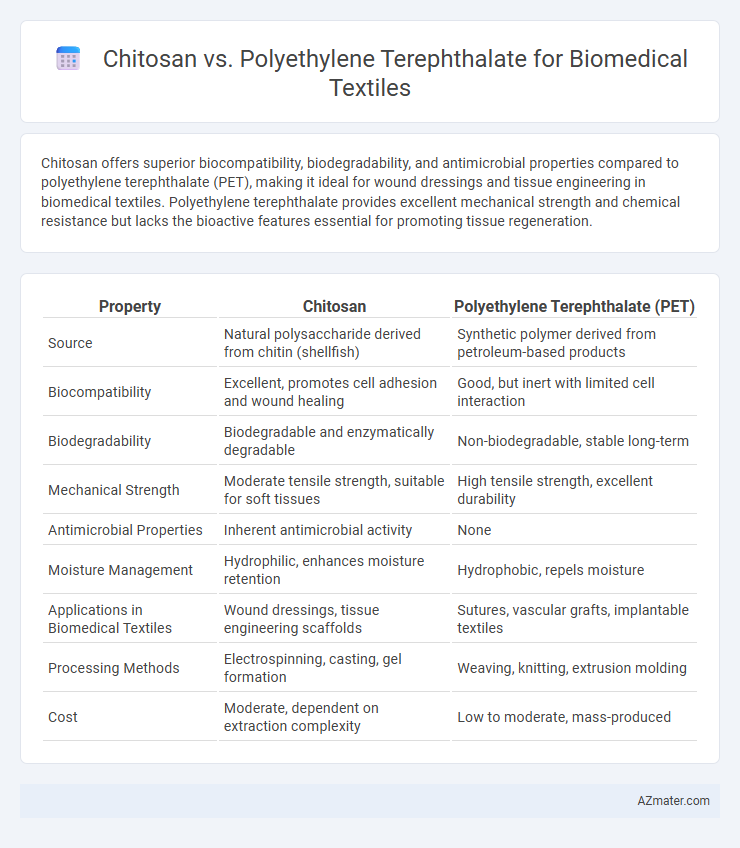Chitosan offers superior biocompatibility, biodegradability, and antimicrobial properties compared to polyethylene terephthalate (PET), making it ideal for wound dressings and tissue engineering in biomedical textiles. Polyethylene terephthalate provides excellent mechanical strength and chemical resistance but lacks the bioactive features essential for promoting tissue regeneration.
Table of Comparison
| Property | Chitosan | Polyethylene Terephthalate (PET) |
|---|---|---|
| Source | Natural polysaccharide derived from chitin (shellfish) | Synthetic polymer derived from petroleum-based products |
| Biocompatibility | Excellent, promotes cell adhesion and wound healing | Good, but inert with limited cell interaction |
| Biodegradability | Biodegradable and enzymatically degradable | Non-biodegradable, stable long-term |
| Mechanical Strength | Moderate tensile strength, suitable for soft tissues | High tensile strength, excellent durability |
| Antimicrobial Properties | Inherent antimicrobial activity | None |
| Moisture Management | Hydrophilic, enhances moisture retention | Hydrophobic, repels moisture |
| Applications in Biomedical Textiles | Wound dressings, tissue engineering scaffolds | Sutures, vascular grafts, implantable textiles |
| Processing Methods | Electrospinning, casting, gel formation | Weaving, knitting, extrusion molding |
| Cost | Moderate, dependent on extraction complexity | Low to moderate, mass-produced |
Introduction to Biomedical Textiles
Biomedical textiles integrate advanced materials designed to interact with biological systems for medical applications such as wound dressings, implants, and tissue engineering scaffolds. Chitosan, a natural polysaccharide derived from chitin, offers excellent biocompatibility, biodegradability, and antimicrobial properties, making it ideal for promoting wound healing and preventing infections. Polyethylene terephthalate (PET), a synthetic polymer, provides strong mechanical stability and durability but lacks the inherent bioactivity of chitosan, limiting its use in applications requiring tissue integration or biodegradability.
Overview of Chitosan: Properties and Applications
Chitosan, a naturally derived biopolymer obtained from chitin, exhibits remarkable biocompatibility, biodegradability, and antimicrobial properties, making it highly suitable for biomedical textile applications. Its ability to promote cell adhesion, wound healing, and controlled drug release outperforms synthetic polymers like polyethylene terephthalate (PET), which lacks inherent bioactivity and biodegradability. Chitosan's versatility in forming hydrogels, films, and fibers enhances its functionality in advanced wound dressings, tissue engineering scaffolds, and antibacterial textiles.
Understanding Polyethylene Terephthalate (PET) in Medicine
Polyethylene terephthalate (PET) is a widely used polymer in biomedical textiles due to its exceptional mechanical strength, chemical resistance, and biocompatibility, making it ideal for applications such as vascular grafts and wound dressings. PET's durability and resistance to hydrolysis enhance the longevity and performance of medical implants and textile-based devices. Compared to chitosan, PET offers superior structural stability, though it lacks the inherent antimicrobial and biodegradable properties beneficial for tissue engineering and drug delivery systems.
Comparative Biocompatibility: Chitosan vs PET
Chitosan exhibits superior biocompatibility compared to Polyethylene terephthalate (PET) due to its natural origin, biodegradability, and inherent antimicrobial properties, which facilitate enhanced cell adhesion and proliferation in biomedical textiles. PET, a synthetic polymer, offers excellent mechanical strength and chemical resistance but lacks bioactivity and can provoke inflammatory responses in long-term implantation. The molecular structure of chitosan promotes favorable interactions with biological tissues, making it more suitable for wound dressings and tissue engineering scaffolds, whereas PET's inertness limits its direct integration in bioactive applications.
Mechanical Properties: Strength and Flexibility Analysis
Chitosan exhibits excellent biocompatibility and biodegradability, making it suitable for biomedical textiles, but its mechanical properties, particularly tensile strength and flexibility, are typically lower than those of Polyethylene terephthalate (PET). PET demonstrates superior mechanical strength and flexibility, providing durability and resistance to wear, which is crucial for long-term biomedical applications such as implants and wound dressings. The balance between chitosan's bioactive properties and PET's robust mechanical performance guides material selection based on specific biomedical textile requirements.
Degradation and Biodegradability in Biomedical Use
Chitosan exhibits superior biodegradability and enzymatic degradation compared to polyethylene terephthalate (PET), making it highly suitable for biomedical textile applications requiring bioresorbable materials. PET's synthetic polymer structure leads to minimal degradation under physiological conditions, resulting in long-term persistence that may cause chronic inflammation. The natural polysaccharide structure of chitosan facilitates controlled degradation through lysozyme activity, enhancing tissue integration and reducing long-term environmental impact in biomedical devices.
Antimicrobial Properties: Chitosan versus PET
Chitosan exhibits strong antimicrobial properties due to its polycationic nature, which disrupts microbial cell membranes and inhibits bacterial growth, making it highly effective for biomedical textiles. In contrast, Polyethylene terephthalate (PET) lacks inherent antimicrobial activity and often requires surface modification or incorporation of antimicrobial agents to prevent microbial colonization. The natural biodegradability and biocompatibility of chitosan further enhance its suitability over PET in applications demanding sustained antimicrobial protection in medical environments.
Environmental Impact and Sustainability
Chitosan, derived from renewable sources like crustacean shells, offers superior biodegradability and lower environmental impact compared to polyethylene terephthalate (PET), a petroleum-based polymer widely used in biomedical textiles. PET's non-biodegradable nature contributes to persistent plastic pollution, while chitosan's natural origin enhances sustainability through reduced carbon footprint and eco-friendly disposal. The integration of chitosan in biomedical textiles aligns with circular economy principles, promoting reduced waste and supporting environmental sustainability initiatives.
Cost-Effectiveness and Manufacturing Considerations
Chitosan offers biodegradability and antimicrobial properties that enhance biomedical textile functionality but typically incurs higher raw material and processing costs compared to polyethylene terephthalate (PET). PET benefits from established mass production techniques, resulting in lower unit costs and consistent mechanical strength suitable for medical applications. Manufacturing considerations favor PET due to its thermal stability and scalability, while chitosan requires specialized processing to maintain bioactivity, affecting cost-effectiveness in large-scale biomedical textile production.
Future Trends and Innovation in Biomedical Textiles
Chitosan's biocompatibility, biodegradability, and antimicrobial properties position it as a promising material in the future of biomedical textiles, enabling innovations in wound dressings, tissue engineering, and controlled drug delivery systems. Polyethylene terephthalate (PET), renowned for its mechanical strength and chemical resistance, continues to dominate in durable medical textiles but faces challenges related to biodegradability and long-term biocompatibility. Emerging trends focus on hybrid composites combining chitosan and PET to enhance functionality, sustainability, and performance in next-generation biomedical textile applications.

Infographic: Chitosan vs Polyethylene terephthalate for Biomedical textile
 azmater.com
azmater.com